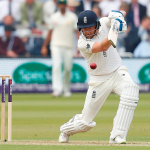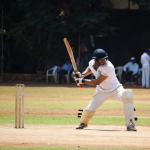After William Gunn and Thomas Moore opened their first sports shop in 1885 they soon decided to diversify into bat making. William was a good enough cricketer to be capped eleven times for England, and he made a timely century in the final Test of the 1893 summer. He was a double international, playing soccer for England as well, but it is that bat making business that causes him to be remembered, Gunn and Moore being to this day a leading manufacturer and supplier of cricket equipment.
William Gunn did not have any sons, so the next generation of cricketing Gunns were the sons of his older brother, John. John Junior was a fine all-rounder, a left handed batsman and left arm spinner who played for Nottinghamshire for almost thirty years. He was capped six times by England. His younger brother George had an equally long career, and for him there were twelve Tests. George’s overall statistics appear at first glance to be nothing more than a little above average, just over 35,000 runs at 35, but he was a much, much better player than those figures suggest, and he was one of the greatest characters the game has seen.
The three Gunns played together frequently for Notts in the last days of William’s career and the early part of George and John’s. Physically they were very different, William being around 6’3” in height. George and John were nothing like so tall. In addition neither nephew, in the fullness of time, demonstrated the same head for business as their uncle. He assisted both greatly in their early years, and took considerable pride in what they achieved, but neither was to play a significant role in the business and indeed in time George and William fell out, and George even became the one Notts batsman who did not use equipment from Gunn and Moore.
In their younger days however William and George were close, and it can only have been as a result of William’s nepotism that George got his first contract with the Notts ground staff as his record in club cricket was unimpressive. He did little to enhance his reputation in his first two years on the staff and, at the end of 1899 and having got nowhere near the first team, George was released.
A somewhat callow youth it seems likely that George suffered from Tuberculosis and, William’s influence at work again, he was sent off to a sanatorium in Virginia Water in Surrey in order to follow a career as a nursing attendant. The lung problems that George had must have improved in his time at the sanatorium, and no doubt that factor was in William’s mind when he arranged the position. George soon became a prodigious run scorer in local cricket, so much so that a contract with Surrey for 1902 (by then he had a residential qualification) was mooted. William intervened again and made sure an offer of a three year contract was made by Notts.
There were seven first team matches for George in 1902, but his best innings was just 20. He developed pretty well however and in 1905 he scored over a thousand runs for the first time before, in 1906, he struggled with his lung problems again. The Notts committee decided to send George to New Zealand for the winter, and although he returned in much better health it was still felt advisable to do the same the following winter. This time around the full England team was due in Australia, led by George’s county captain Arthur Jones. It was arranged that George would accompany the side, the intention being that he would act as scorer and be available to play in some of the up-country fixtures.
By the time the series began Jones was ill, and George was selected to play. Given that he was not even in the tour party his selection ahead of Jack Hobbs for the first Test caused some consternation, not least amongst the rest of the tourists themselves. All-rounder Len Braund is said to have had no compunction about voicing his thoughts on the subject within George’s earshot.
England won the toss and batted and lost both openers with just 18 on the board. There was then a partnership between George and another debutant, Kenneth Hutchings. The Kent amateur’s dismissal brought Braund to the wicket. George remembered what he had heard, and proceeded to farm the bowling with such efficiency that Braund barely faced a ball for the best part of an hour. After tiring of that, and having reached 78, George then unfurled six consecutive fours to go to a debut century. He top scored in the second innings as well with 74, although his efforts did not prevent an Australian win by two wickets.
Ironically enough the only Test in the series that England won, the second, was George’s solitary failure. After that he managed another century in the fifth Test at Sydney. Such success, he topped the averages at 51.33, would normally have guaranteed a start in the next home Test, but in those days the system was a little different. For various reasons Archie MacLaren, CB Fry, Gilbert Jessop, Tom Hayward and JT Tyldesley had all been unavailable in 1907/08, but all were back in contention when the Australians arrived in 1909. George didn’t make the side for the first Test, but came in for the second at Lord’s. Palpably out of form going into the match he scored 1 and 0. It was to be the only time he was picked to play for England in England.
In 1911 George managed his highest aggregate of runs to date, 1,577. Had Jessop or Fry been available he probably wouldn’t have toured Australia again that winter, but they weren’t and a word from Jones, and the decent impression he had already made on Warner, meant that he got the nod again. This time the result was a 4-1 win. Hobbs and Wilfred Rhodes were England’s outstanding batsmen, but George averaged 42.33 and passed fifty four times. His reputation is as a fine player of pace bowling, but in this series he showed his all-round batting prowess, being much less troubled by the Australian wrist spinner Ranji Hordern than most of his teammates.
The Golden Age of cricket ended with the outbreak of the Great War at the end of the 1914 summer. The previous year George had been magnificent, averaging just a tick under 50 and being chosen as one of Wisden’s Five Cricketers of the Year. In 1914 however his average had dropped by 17, and in a most unusual kind of comment for Wisden the editor had commented; Why a batsman of his rare gifts should so often allow half volleys to go unpunished is a puzzle we cannot attempt to solve.
There are many examples of George’s contrary nature. At Bradford in 1927 he had an animated discussion with Neville Cardus about defensive play, in the course of which George had expressed a strong disapproval of the sort of unenterprising play that Cardus would on occasion extol the virtues of. George then went out to bat and took four hours over compiling a painstaking 48. By the time he was first out at 184 his partner ‘Dodger’ Whysall was well past his century. George expressed the hope that Mr Cardus enjoyed his ‘little joke’.
On a slightly different theme in 1913 Yorkshire visited Trent Bridge and knocked up the small matter of 471. There was no chance of a Notts victory and the best they could do was draw. George scratched around for six hours for 132 to put the game beyond the visitors. The Yorkshireman made a few critical observations along the lines of ‘hast tha lost tha strokes George’. Yorkshire declared their second innings and left Notts 85 minutes to bat out – George was unbeaten on 109 when the game ended. The next highest scorer was brother John, who scored eight.
One of the reasons George’s tally of runs was not higher was the fact that he was not sufficiently single minded in the pursuit of runs. He did not enjoy batting without a challenge, or anything that upset his plans. Well known stories of that sort are the occasion when he got himself out on the stroke of half past one in a match where lunch was, unusually, due to be taken at two o’clock. George told the umpire that he did not mind what the rest of them did, but that he had his lunch at one thirty. In similar vein on another occasion, having agreed to meet his wife for a picnic lunch at the ground at a specific time, he got himself out as soon as he saw her arrive. Legend has it that to make sure she knew he had not forgotten he made sure the means of his dismissal was by lofting the ball into the outfield towards where Mrs Gunn had parked the car.
George did not immediately go to War, but in 1915 volunteered for the Army Service Corps. He did not therefore see action on the front line, but was in France for several months before, in 1917, he was invalided home. It is unclear why, and there is no indication he was wounded, so the assumption has always been made that his lungs were troubling him again. In any event before the end of the war he was to be seen, along with the likes of Jack Hobbs and Sydney Barnes, playing cricket professionally in the Bradford League. He was also working at that time in the Gunn and Moore factory, clearly being groomed at that point for a senior position. Exactly what eventually caused George and William to fall out in 1920 is unclear.
In the twenty first century few cricketing careers last eighteen years in total, let alone such a time passing between Test appearances, but that is exactly what happened to George when he was selected to tour the West Indies in 1929/30. He wasn’t the only veteran, Wilfred Rhodes and Andrew Sandham also getting the call, but despite being 48 George was in the side on merit. The previous summer Notts had finally, 22 years after their last triumph, lifted the County Championship and George had had a fine summer. In fact the years 1927-29 were the three highest aggregates of his career.
It therefore transpired that after all those years George played four more Tests. He did well on the tour overall averaging 41. In the four Tests he was slightly less impressive, averaging only 34 and taking just a single half century in the four matches, but he was dismissed in single figures only once and caused a minor sensation amongst the locals with his habit of wandering down the pitch to face the fastest bowlers. The local press described him as the man who walks down the pitch and tickles them where he likes.
George was also popular with the crowds who he would regularly play up to. His favourite pastime was, when two batsmen were having a mid wicket discussion, to creep towards them in theatrical fashion with his hand cocked behind his ear. The spectators would then shout to their favourites ‘he’s comin’ to listen’, and George would then put his finger to his lips and retreat on tip toes to his place in the field.
In 1928 another Gunn, George junior, had made his county debut. Young George was never going to be the player his father was but he proved a solid county pro throughout the 1930s, scoring his thousand runs in each of the five summers leading up to World War Two, and proving a sufficiently useful change bowler with his leg breaks to manage as many as 77 wickets in 1934. In 1931 at Edgbaston George, 52 years young, scored what proved to be the last but one of his 62 first Class centuries. At the end of the game the Warwickshire skipper Bob Wyatt was prevailed upon to allow an additional over to be bowled, during which George junior reached his hundred as well, a unique family double.
At the start of 1932 George did not begin the season with any thought that it would be his last. In the first match of the season little seemed to have changed as he contributed a fluent 67 to a 132 opening partnership against Sussex. The next game was against Surrey, also at Trent Bridge. Surrey batted first and were dismissed for 108. Conditions were not good and in particular it was quite dark. Surrey’s opening attack was led by Alf Gover, who was distinctly sharp.
Gover had a long run, 17 yards, and stood for some seconds at the end of his mark furiously rubbing the ball to try and fully remove a greasy residue from it. Both the umpire, Frank Chester, and Gover’s captain, Douglas Jardine, told him to get on with it. Neither was the sort of man a 24 year old professional bowler would argue with so he began his run. In his delivery stride the ball slipped out of his hand and a full speed head high beamer was the result. George tried to hook the ball, but missed and was struck just above the right eye.
Having fallen on his stumps George was out anyway, not that he would have been fit to carry on with his innings. Gover visited him in hospital later and was told by George’s doctor that had the contact been an inch higher George would probably be dead. It was a sobering moment for the Surrey fast bowler, although he would doubtless have felt comforted by George telling him not to blame himself, and that it was his fault for misjudging the line of the ball.
Out for six weeks when George came back he seemed in good form and made a couple of half centuries, but his last match came in early July against the Indian tourists. He scored 0 in the first innings and 20 in the second caught at slip both times. He clearly did not relish playing the slippery pace of Amar Singh. It was a sad way to end the career of a man who was undoubtedly one of the great players of fast bowling.
One of the remarkable aspects of George’s career is that in 1921, when batsmen came in and out of the England side as if through a revolving door, George was not selected to face the twin menace of Gregory and McDonald that so shattered the confidence of most of those who did play. Ciss Parkin, McDonald’s long time Lancashire teammate, wrote of George; Even McDonald didn’t like bowling against him – he was the only batsman of whom ‘Mac’ stood in awe. Fred Root would tell a similar story about Arnold Warren of Derbyshire, and that great batsman Wally Hammond fully endorsed all that was said writing that George was; the only batsman I have ever seen who revelled in the fastest bowling.
His playing days over George, like so many sportsmen before and since, became the landlord of a local hostelry. He wasn’t a great businessman, but was a hugely popular host and the local police would apparently turn a blind eye to his poor timekeeping so far as opening hours were concerned. The spirit of bonhomie together with the rather better grasp on simple economics that George’s wife had meant that between them they made a success of their time at the Bentinck Hotel in the centre of Nottingham.
On the outbreak of War George sold the hotel and bought a house in a popular residential area of the city. He was only 60 however so did not retire, taking a job as an inspector at George Brough’s factory in nearby Basford. Brough was the man who created the Brough Superior, the Rolls Royce of motorcycles, and George was as popular there as he was everywhere else. After the War he was called in to help the Nottinghamshire club recruit new members and, deservedly, was one of the first group of former professionals to be given honorary memberships of the MCC. He was often to be found at Trent Bridge in the 1950s, accompanied by brother John.
In 1956 George’s wife died, and then a year later George Junior lost his life as a result of a motorcycle accident. It was hardly surprising that two such blows would knock the wind out of George’s sails and he died two years later in 1958, shortly after celebrating his 79th birthday, whilst visiting the home of his surviving son, Jack, in Sussex. Jack’s successes had come in business rather than on the cricket field, but he had been a promising player himself before realising that his father’s reputation was too heavy a burden to bear. George’s body was brought back to Nottingham and the funeral service was exceptionally well attended as Nottingham remembered one of its favourite sons.
from Cricket Web https://ift.tt/2IumZxr


